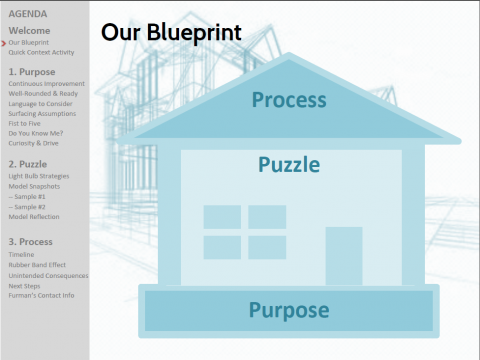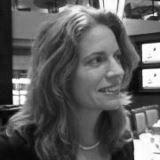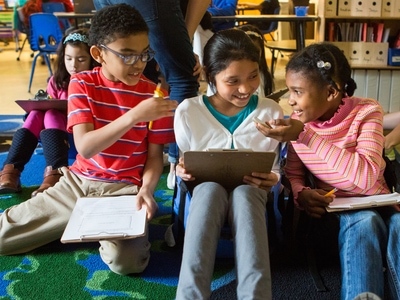New Designs for School
Chicago Schools Are Rethinking K-12 Staffing and Scheduling
Topics

We’ve all had the experience of truly purposeful, authentic learning and know how valuable it is. Educators are taking the best of what we know about learning, student support, effective instruction, and interpersonal skill-building to completely reimagine schools so that students experience that kind of purposeful learning all day, every day.
Practitioner's Guide to Next Gen Learning
Breakthrough Schools: Chicago offered school teams a workshop on extending the reach of great teachers and reimagining schedules to generate better, deeper, and different learning.
One Friday in July, I joined 16 Breakthrough Schools: Chicago (BTSC) school teams who spent the day rethinking their assumptions behind school and reinventing the learning experience for their students. They’re the second cohort of planning participants to be supported by LEAP Innovations, the coordinating partner of BTSC and designer of BTSC workshops.
BTSC offers a 10-month learning experience tailored around critical topics and needs in next gen and personalized learning. The workshop I attended focused on scheduling and staffing. Experts Stacey Shumake of Public Impact and Furman Brown facilitated the session.
Does your schedule reflect your learning values? Does it support and enable your school mission?
Are you getting the most out of your excellent teachers? How are you supporting newer teachers?
Most of the teams that participated in the workshop are part of an existing school and yet actively planning and piloting their own redesigned school model. I was introduced to Errika Baker and Alan Mather, both principals but from very different schools. Errika leads a charter elementary school and has formerly worked in Montessori settings and the Nobel Network. Her preK-5 school, University of Chicago Charter School, Donoghue Campus, is located on the south side of Chicago. Alan is a seasoned secondary leader of a district high school grades 7-12. He formerly worked at Northside College Prep and is now at Lindblom Math & Science Academy, a school that requires all students to take Mandarin or Arabic and offers a biotechnology program (through a partnership with Baxter International).
Furman and Stacey asked Errika, Alan, and all of the participants to reflect on the role and influence of staffing and scheduling to support each team’s mission and ability to tailor instruction to student needs. Listen to what Errika and Alan hoped to learn from this workshop:
Extending the Reach of Great Teachers
Starting us off, Stacey asked, “Are your most experienced teachers being paid to coach and support novice teachers? Or, is technology being used with students to practice skills while simultaneously freeing up some collaborative coaching time or additional instruction time with students?” She shared several examples of different staffing configurations that pair well with specific school objectives, strengths, or needs. Teams discussed these to find the best fit for their model.

Stacey also pointed teams to the Opportunity Culture website for additional free tools to help them extend great teaching to all their students, pay excellent teachers more within current budgets, and give teachers in-school time to collaborate with peers. See There’s no one-size-fits-all instruction for students; and, after listening to Stacey, also apparently no one way of organizing valuable teaching resources. This is eye-opening and valuable given how instrumental good teachers are in influencing student achievement. Similarly, the key to retaining staff, building a strong culture, and sustaining performance is found in establishing a trusting, respectful, and joyful teaching environment.
Puzzling Out the School Schedule
Transitioning rooms, I found Furman, formerly of Generation Schools Network. He has a lot of experience working on what he calls the “puzzle” part of school… the schedule. Generation Schools showed us just how much you could reimagine teacher and student schedules to generate better, deeper, and different learning. Furman asked the Chicago teams to first reconnect with their vision for learning. Here’s his: To generate students that are “well rounded and ready,” he says.

In order to enable this vision for a whole child experience, Furman continued, “you’ll need to revisit all your assumptions about learning and deconstruct them. Do you believe that the best learning model in elementary school is to have all teachers teach all subjects? Do you believe that a second language is best learned in high school?” (Brain scientists think it’s best learned in elementary.) Furman asked teams to revisit their mission and purpose in order to deconstruct those old invisible assumptions and then build the new puzzle and process from this new purposeful foundation.

Changing the Fundamentals of School
Because these operations—scheduling and staffing—are “the fundamentals of school,” they’re also topics on the “most likely to be taken for granted list”—meaning, they remain largely the same, or if they are tweaked, default back to known norms when changes in leadership or funding occur. Listen to Furman and Stacey summarize those points. I asked Errika and Alan to share their big takeaways and to answer the questions: “Now what? What are you inspired to do next?”
Errika really honed in on the best staffing and time use strategies. Alan’s comments reveal that he was thinking about how technology (which he already has) can support more student choice and an expanded reach of the curriculum in a competency design, which, by the way, was the topic of the previous BTSC workshop. Like other participants, Alan had already started making connections across workshops in the BTSC series.
From Errika, Alan, and others at the workshop, I saw hints of a more complete vision for what learning is becoming across this Chicago-based network of schools.
Taking the Time Professional Learning Requires
It seems some of the power of workshops offered by regional partners like LEAP (and others doing next gen work) is the synergy created by combining interrelated topics over time and providing opportunities to visit local and national school models (here’s more from Alan on this point). In my discussions with Errika and Alan, they both expressed an appreciation for the following features of the BTSC workshop series:
- Extended time to learn new content (topics, as Furman explained, that aren’t taught elsewhere)
- The quality of national and local expertise (available 1:1 through office hours/coaching)
- The support to plan and iterate
- The opportunity to be part of a like-minded community of practitioners
I’m reminded that education is fundamentally a people and relationship business. And that teacher professional growth matters. It’s great to see local entities like LEAP making significant investments in teachers, supporting their knowledge and ability to create next gen learning.




